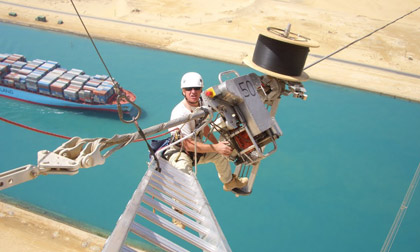Saving in distance via the Canal and the Cape:

| From |
To |
Distance
( Nautical miles )
|
Saving |
| SC |
Cape |
Mile |
% |
| Ras Tanura |
Constanza |
4144 |
12094 |
7950 |
66% |
| Lavera |
4684 |
10783 |
6099 |
57% |
| Rotterdam |
6436 |
11169 |
4733 |
42% |
| New Orleans |
9645 |
12299 |
2654 |
22% |
| Jeddah |
Rotterdam |
1320 |
11207 |
9887 |
88% |
| Rotterdam |
6337 |
10743 |
4406 |
42% |
| Tokyo |
Rotterdam |
11192 |
14507 |
3315 |
23% |
| Singapore |
Rotterdam |
8288 |
11755 |
3647 |
29% |
Advantages of Suez Canal
Longest Canal in world with no locks
Percentage of accidents is almost nil Compared with other waterways.
Navigation goes day and night.
Liable to be widened and deepened when required to cope with the expansion in ship size.
The VTMS (Vessel Traffic Management System) has been introduced. It is a very accurate electronic system envisaging a most up to date radar network.
The Suez Canal can now accommodate all mammoth tanker in service on their ballast trips.
Importance of the Suez Canal
The unique geographical position of the Suez Canal makes it of special importance to the world and to Egypt as well.
This importance is getting augmented with the evolution of maritime transport and world trade.
The maritime transport is the cheapest means of transport, whereas more 80% of the world trade volume is transported by means of sea routes.
Saving in time and in operation costs for vessels that transit the Canal, also consolidate this importance.
Historical Outline
Egypt was the first country to dig a man–made canal across its lands to
connect the Mediterranean Sea to the Red Sea via the River Nile and its
branches, and the first who dug it was Senausret III, pharaoh of Egypt
(1874 B.C.) This Canal was abandoned to silting and reopened several times
as follows:
Canal fo Sity I: 1310 B.C.
Canal of Nkhaw: 610 B.C.
Canal of Darius I: 510 B.C.
Canal of Ptolemy II: 285 B.C.
Canal of the Romans: 117 B.C.
Canal of Amir El Moemeneen: 640 A.D.
Following the Islamic conquest and remained open for 150 years.
The Suez Canal is actually the first Canal directly linking the
Mediterranean Sea to the Red Sea. It was opened for international
navigation on 17 November 1869.
Egypt nationalized its Canal on 26 July 1956.
The Canal was closed five times, the last time was most serious since it
lasted for 8 years.
The Canal was then reopened for navigation on 5 Jun 1975.
Characteristics of the Present Canal

| Overall Length |
190.25km |
| From the fairway buoy to Port-Said lighthouse |
19.50km |
| From the waiting area to the southern entrance |
8.50km |
| From Port-Said to Ismailia |
78.50km |
| From Ismailia to Port-Tewfik |
83.75km |
| The length of double parts |
78km |
| Width at water level (North / South) |
345 / 280m |
| Width between buoys (North / South) |
210 / 195m |
| Maximum permissible draught for ships |
62ft |
| Cross sectional area (North/South) |
4800 / 4350m2 |
| Maximum deadweight tonnage |
210000tons |
| Permissible speed for loaded Tankers |
14km/hr |
| Permissible speed for ballast Tankers and ships |
13km/hr |


